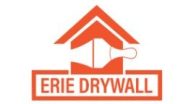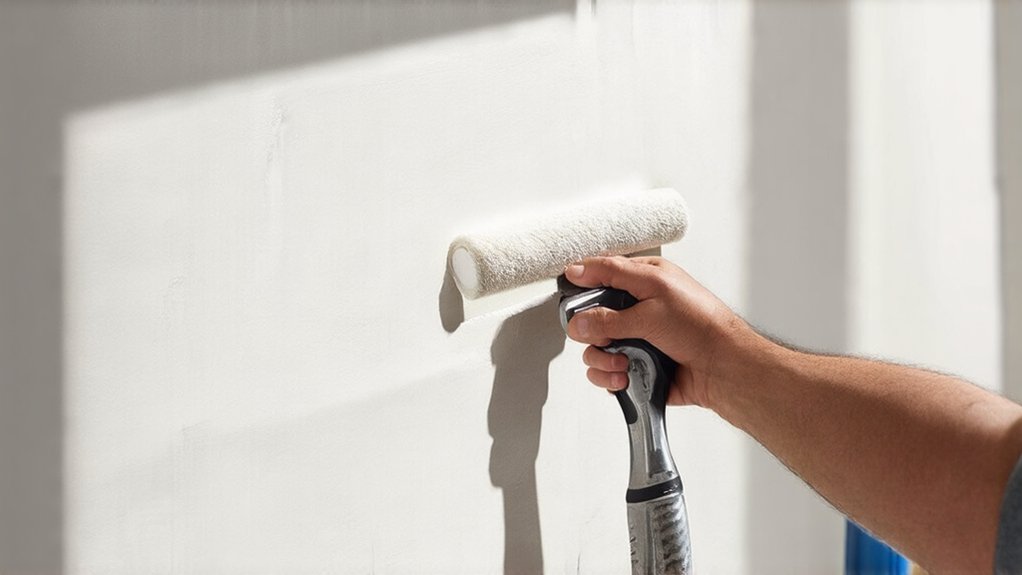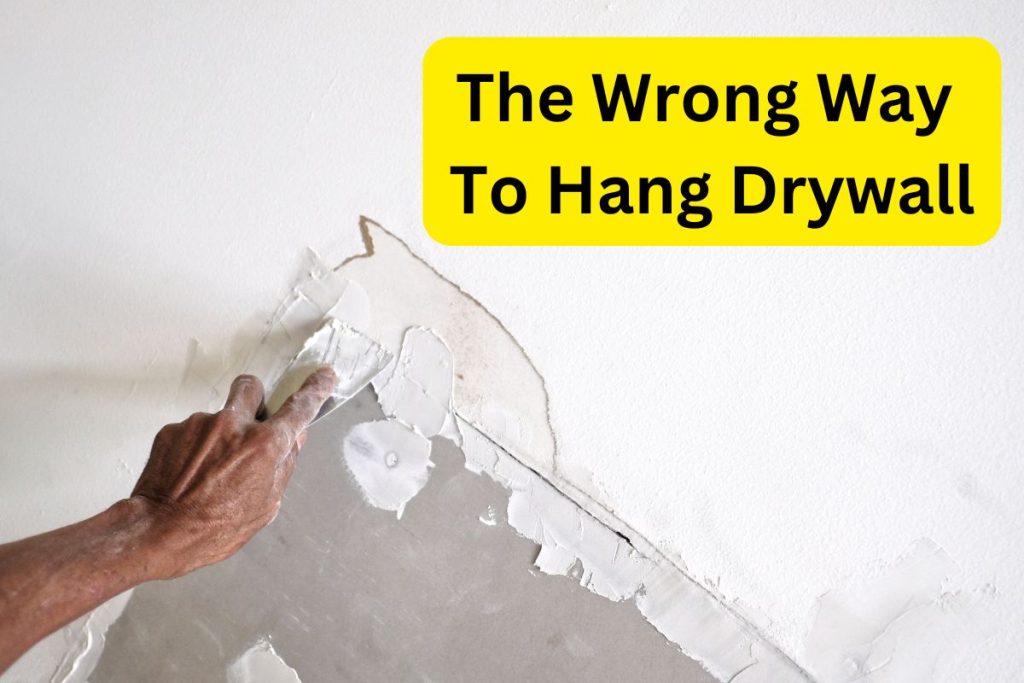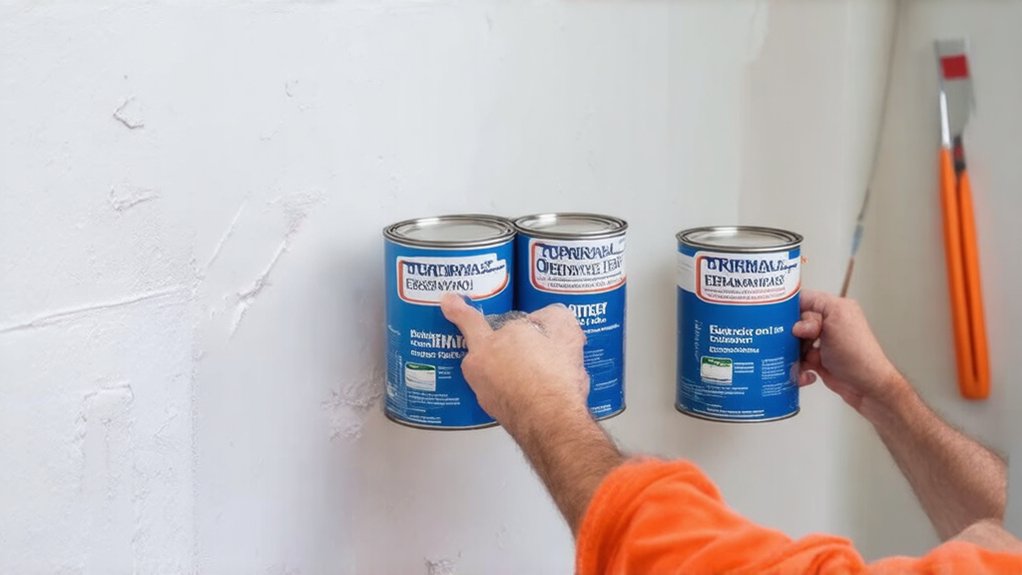To paint new drywall without streaks, you'll need to prime the surface first and choose the right tools. Sand down any imperfections and apply a quality drywall primer using a smooth roller technique. Select a latex paint with a flat or low-sheen finish, and use a ½ inch nap roller. Apply paint in a consistent "W" or "M" pattern, maintaining even pressure and overlapping each stroke by 50%. The full guide ahead reveals even more professional painting secrets.
Understanding Drywall Porosity and Paint Absorption
Drywall's porous nature can be a painter's silent nemesis when it comes to achieving a flawless finish. Different paint surface compositions interact uniquely with drywall texture variations, creating challenges for even the most experienced DIY enthusiast. You'll want to understand how raw drywall absorbs paint differently than primed surfaces, which can lead to uneven coloration and frustrating results.
The microscopic holes and rough texture of new drywall create a sponge-like effect, potentially drinking up your paint and creating patchy, inconsistent coverage. Knowing these characteristics helps you prepare and approach your painting project with confidence and skill. Drywall repair experts recommend professional priming techniques to ensure uniform paint absorption and superior finish quality.
Essential Tools and Materials for a Smooth Paint Job
Gear up and gather the right tools before diving into your drywall painting project. You'll need high-quality paint rollers with the proper nap length for smooth surfaces, ensuring even paint application method. Select a roller frame that feels comfortable and sturdy, along with extension poles for hard-to-reach areas. Drywall installation experts recommend using moisture-resistant drywall materials for long-lasting paint performance. Choose angled paintbrushes for cutting in edges and corners precisely. Don't forget painter's tape, drop cloths, paint trays, and a ladder for all-encompassing coverage. Investing in quality tools upfront will save you time and frustration, helping you achieve a professional-looking finish that'll make you proud of your DIY skills.
Preparing and Priming Your New Drywall Surface
Now that you've equipped yourself with the right tools, it's time to focus on prepping your new drywall for a stunning paint job.
Start by carefully inspecting the surface for any imperfections like bumps, seams, or uneven joints. Sand down rough areas and apply drywall joint compound to create a smooth, seamless surface. Once the compound dries, sand it again until perfectly even.
Next, choose a high-quality primer specifically designed for new drywall. Apply the primer evenly using a roller, ensuring complete coverage and creating an ideal foundation for your paint.
Selecting the Right Paint and Application Technique
After preparing your drywall surface, choosing the right paint and application technique can make all the difference in achieving a professional-looking finish. When selecting paint, opt for a high-quality, latex interior paint with a smooth finish that'll cover imperfections effectively.
For new drywall, a flat or low-sheen paint works best, helping to minimize surface irregularities. You'll want to use a roller with the right nap length—½ inch for smooth surfaces—and apply paint in a "W" or "M" pattern for even coverage. Don't rush; take your time to guarantee a seamless, professional result.
Best Practices for Even Paint Coverage
With your roller and paint selection in hand, achieving a smooth, uniform paint finish requires strategic application techniques. Your success depends on precision and patience.
Consider these best practices for even paint coverage:
- Apply primer first to create a uniform base and elevate paint adhesion
- Use high-quality rollers with appropriate nap length for your surface texture
- Maintain consistent pressure and overlap each stroke by 50% for seamless coverage
- Consider paint sheen considerations like eggshell or satin for balanced appearance
Troubleshooting Common Painting Mistakes on New Drywall
Have you ever stepped back from a freshly painted wall, only to notice unsightly imperfections that make your hard work look unprofessional? Common painting mistakes on new drywall can be frustrating, but they're easily fixable.
Uneven paint roller techniques often cause streaks and patchy coverage. When applying paint, use consistent, overlapping strokes and maintain a wet edge to prevent visible lines.
Paint brush application requires gentle, uniform pressure and careful loading of paint. Don't overload your brush or press too hard, which can create thick, uneven areas. Patience and technique are key to achieving a smooth, professional finish.
Frequently Asked Questions
How Long Should I Wait Between Priming and Painting New Drywall?
You'll want to wait 24 hours after priming for ideal curing time. Guarantee your drywall surface is thoroughly prepped and permit the primer fully dry before painting to achieve a smooth, professional finish everyone will admire.
Can I Use Cheap Paint Rollers on Fresh Drywall Surfaces?
You'll want quality rollers with consistent nap length to avoid roller quality issues. Cheap rollers can leave fuzz, streaks, and uneven coverage. Invest in a good medium-nap roller for smooth, professional-looking results that'll make you proud of your drywall painting project.
Will Painting in Direct Sunlight Affect My Drywall Paint Finish?
You'll want to avoid direct sunlight exposure when painting, as temperature variations can cause rapid drying, leading to visible roller marks and uneven paint application. It's best to work in controlled, indirect light for a smooth, professional finish.
Do I Need Special Paint for Bathrooms or Kitchens?
You'll want moisture resistant, mildew resistant paint for bathrooms and kitchens. These specialized formulas protect your walls from humidity and potential mold growth, ensuring your space looks great and stays clean in high-moisture environments.
What's the Best Temperature Range for Painting New Drywall?
You'll want to paint when the ambient temperature is between 50-85°F and humidity's around 40-50%. These conditions help your paint dry evenly, preventing streaks and ensuring a professional-looking finish that'll make you proud of your home improvement project.



